Table of Contents
SaaS Management is a strategic imperative, but too often, programs stall in the justification phase. You implement a platform, connect a few data sources, and surface initial insights. Then leadership asks the question: What value is this program actually delivering?
For IT teams driving adoption, that question becomes a real challenge. You’re expected to show results before the program reaches maturity. Without early, visible wins, internal support fades, and the platform risks becoming shelfware.
That’s why quick wins matter. They validate your investment, show momentum, and keep stakeholders engaged. More importantly, they build trust in your leadership and the broader promise of SaaS Management.
The 2025 SaaS Management Index found that most organizations underestimate their SaaS spend by 304%. That disconnect highlights the need for fast, measurable results.
Let’s walk through five tactical wins that demonstrate value quickly while building a strong foundation for long-term success.
5 SaaS Management Quick Wins That Drive Business Outcomes
SaaS Management programs typically drive business outcomes in four pillars: visibility, cost savings, cost avoidance, and compliance. Below are five SaaS Management quick wins to help your organization achieve these outcomes.
Quick Win #1: Eliminate Redundant Apps with a Real-Time Inventory
Most IT teams operate without full visibility into their SaaS environment. The average organization manages 275 SaaS applications, and each year that portfolio could grow as much as 33%. With that kind of sprawl, duplication becomes almost inevitable.
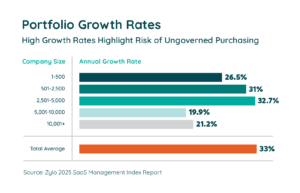
When software is purchased across departments without central oversight, it’s common to find several tools performing the same function. Teams may adopt different design platforms, collaboration apps, or workflow tools, each serving a similar purpose but adding cost and complexity. For instance, we’ve found that organizations have 10 project management tools on average. These redundant tools fragment the user experience and inflate spend.
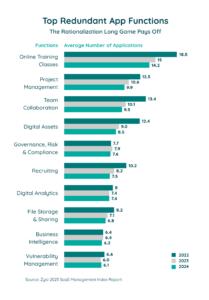
Quick wins come from identifying consolidation opportunities ahead of contract renewals—a more tactical approach to app rationalization. Focus on apps with:
- Low login activity
- Small user counts
- Feature overlap with better-adopted platforms already in place
Zylo’s AI-powered discovery engine makes this process faster and more precise. Apps are discovered and automatically tagged by functionality, category, and subcategory, helping IT teams pinpoint redundancy across the environment. Dashboards highlight low-value apps with upcoming renewals, giving you the insight needed to take action before spend is locked in.
How to Take Action
Implement these steps for tactical app rationalization and eliminate redundancy in your stack.
- Connect key data sources. Integrate AP, SSO, and expense data into your SaaS Management Platform for a complete view.
- Review platform categorizations. Group tools by functionality to uncover overlap and identify redundant spend.
- Filter for applications up for renewal in the next 90 to 120 days. Evaluate usage, adoption, and user overlap for these applications.
- Based on your analysis, determine which apps should be deprecated, or canceled.
- Build the business case. Use dashboards to quantify potential savings and support SaaS consolidation recommendations.
- Cancel applications, keeping your vendor’s notification period in mind.
Quick Win #2: Reclaim Wasted Spend from Unused Licenses
Inactive licenses drain budgets without delivering value. In fact, 53% of all SaaS licenses in the average organization go unused. Annually, that equates to $21M in wasted spend. That’s not a rounding error—it’s a recurring, scalable source of waste that compounds with every renewal cycle.
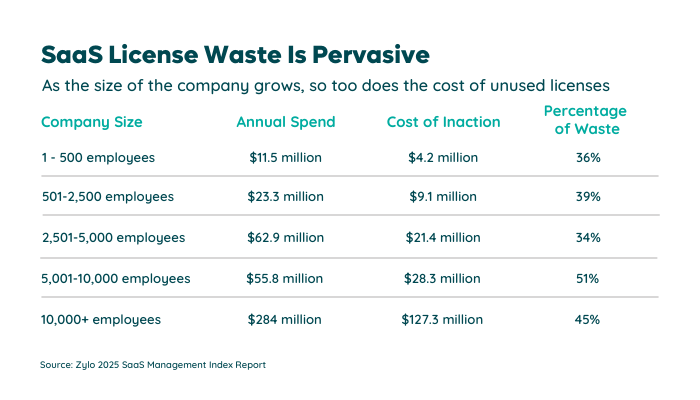
Each inactive license represents an opportunity to cut costs or redirect spend toward tools that actually support the business. Left unmanaged, license waste drives up operating expenses and weakens the business case for new investments.
This is one of the most immediate and provable SaaS Management wins. With accurate usage data and well-timed workflows, IT can recover value fast without disrupting day-to-day operations.
Zylo automates this process by pulling login frequency, feature adoption, and license-level activity from your core SaaS tools. The platform flags inactive users, highlights licenses that are ready for reclamation, and powers automated workflows to deprovision or reassign access—no manual audit required.
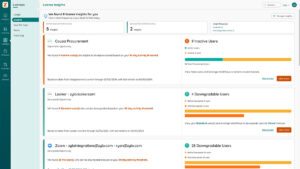
At ModMed, the IT team used Zylo to automate license cleanup campaigns. Their first effort earned direct praise from executive leadership, who saw it as proof that the environment was being managed with discipline and precision. To date, ModMed has achieved over $3M in cost savings and avoidance via automated license reclamations.
“I got a thank you from [an executive] on these emails going out, because they know that we’re keeping our eye on the ball. This tells them that we do have a governed tech environment. Being able to keep track of that on a regular basis is a huge win for us here at ModMed.”
— Trenton Cycholl, VP, Digital Business at ModMed
How to Take Action
Operationalizing license management is key to reducing waste. Follow these steps:
- Connect usage data. Integrate your core SaaS tools with your platform to track real-time user activity at the license level.
- Prioritize applications for license reclamation. For quick ROI, focus on the highest-dollar or IT-owned apps with renewals in the next 90 days.
- Identify inactive users for priority apps. Use built-in insights to surface licenses with no activity in the last 30, 60, or 90 days. The license threshold you use may depend on your business or the usage expectations of the application (e.g. daily use app vs monthly use app).
- Launch license reclamation workflows. Automatically notify users, confirm licenses to deprovision, and remove users as needed.
- Partner with Procurement to confirm license needs ahead of renewal. Rightsize licensing in your new contract.
- Quantify the impact. Measure the value of reclaimed licenses and report cost savings following renewals.
ModMed Drives Operational Excellence & Million-Dollar Savings with Zylo SaaS License Management
Discover how ModMed used Zylo’s powerful license tracking and optimization to save millions of dollars, drive operational excellence, and improve the employee experience.
Quick Win #3: Automate User Offboarding to Cut Risk
Employee offboarding is one of the most overlooked levers in SaaS Management. When someone leaves your company, their software access shouldn’t linger. Yet in many organizations, offboarding is inconsistent, manual, and incomplete.
That’s not just an efficiency issue—it’s a security liability. Former employees with access to SaaS apps may retain entry to sensitive systems, files, or communication channels. Unrevoked licenses also represent lost dollars that could be reclaimed or reassigned.
Zylo helps IT teams close these gaps automatically. By integrating with SSO and HRIS systems, the platform identifies when employees exit and cross-references license assignments across your SaaS environment. This creates a real-time list of accounts that need attention, including licenses tied to inactive users.
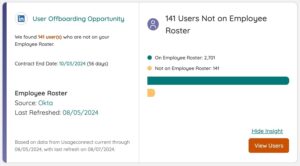
That visibility allows IT to act quickly. Rather than relying on ticket queues or spreadsheets, teams can proactively deprovision access, recover spend, and reduce potential risk exposure. It’s a fast, repeatable process that turns a common oversight into a consistent win.
The need for automation is growing. SaaS portfolios are ballooning, increasing the risk of missed offboarding steps and scattered ownership.
How to Take Action
Address user offboarding gaps with these steps:
- Integrate identity and HRIS systems into your SaaS Management Platform. It compares the employee roster to SSO users to pinpoint users who are no longer at your company.
- Set up automated alerts to monitor for employee departures. Use platform insights to identify licenses still assigned to former employees.
- Revoke access and reclaim seats. Take immediate action to deprovision tools—through your ITSM tool or sharing the list of users with app owners/admins.
- Document the outcome. Maintain records to support compliance audits and track the value of reclaimed licenses.
Quick Win #4: Remediate Shadow IT Before It Spirals
Shadow IT is no longer a fringe problem—it’s deeply embedded in the enterprise. In fact, it makes up 45% of applications in the average company’s portfolio.
Employees regularly purchase software without IT involvement, often through expense reports or corporate cards. This behavior bypasses standard vetting processes and introduces new risk with every transaction.
Today, 84% of apps in the average SaaS portfolio are procured outside of IT oversight. Even more concerning, 60.8% of those tools have poor security ratings. Without visibility into this spend, organizations face unnecessary duplication, financial leakage, and compliance exposure.

Zylo gives IT the tools to identify and contain shadow IT before it becomes a systemic issue. By integrating data from expense platforms, AP systems, and card programs, the platform surfaces which apps are being purchased, who’s purchasing them, and how much is being spent. Usage and risk scoring add further context, allowing IT to assess whether to block, monitor, or legitimize the tool.
Real-time alerts notify teams when new apps enter the environment. This lets IT move quickly, redirecting users to approved alternatives or launching formal evaluations when appropriate. The result is better governance without compromising speed or innovation.
At AbbVie, this visibility helped IT and Finance realign software acquisition with enterprise strategy. By tightening its expense policy and layering Zylo’s spend data, they reduced unauthorized expense purchases by 47% and brought rogue tools back under control.
How to Take Action
Follow these steps to identify and remediate shadow IT.
- Connect financial systems to your SaaS Management Platform. Ingest data from expense, AP, and credit card platforms to uncover non-standard software purchases.
- Identify shadow IT. Use platform dashboards to view app-level spend by user, department, and source.
- Assess risk and act. Review security scores and determine whether to approve, consolidate, or remove each tool.
- Establish guardrails. Publish a vetted app catalog and purchasing policy to guide employees toward secure, supported software.
Quick Win #5: Use SaaS Price Benchmarks to Save Money at Renewal
With 247 renewals each year for the average company, there are many opportunities to reduce costs in a meaningful, lasting way. Yet many organizations let those opportunities slip due to rushed timelines, missing data, and reactive negotiation strategies. Without a detailed understanding of usage patterns and competitive pricing benchmarks, IT and Procurement teams lose their leverage and settle for more of the same—often at a higher cost.
The challenge is growing. Vendors are evolving their pricing models rapidly, adding AI feature bundles, experimenting with consumption-based pricing, and introducing new tiers that shift the value equation. Without external benchmarks, it’s hard to know whether you’re overpaying or whether the terms on the table are truly competitive.
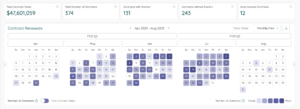
This is where Zylo delivers unmatched value. With a rolling Renewal Calendar, teams can see 90 to 120 days ahead and plan accordingly. Built-in usage analytics offer detailed views at the app, feature, and license level. But most critically, Zylo provides price benchmarking based on anonymized data across the largest SaaS dataset in the industry. This allows you to evaluate how your pricing compares to similar companies and contracts—and to challenge inflated quotes or unnecessary upgrades with confidence.
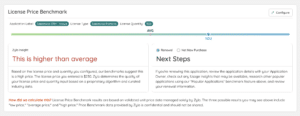
From there, Zylo’s Savings Center tracks the financial impact of renewal savings tied to price benchmarking. It provides clear, auditable evidence of cost avoidance when licenses are rightsized, pricing is improved, or vendors are renegotiated. Savings Center doesn’t just flag opportunities; it quantifies what you actually saved and ties it back to each renewal event. The result isn’t just a more efficient renewal process—it’s real cost avoidance, backed by market data and operational clarity.
How to Take Action
To reduce SaaS costs at renewal, follow these steps and best practices.
- Add contract details. Ensure each application’s record in your SaaS Management Platform includes contract start and end dates, payment terms, auto-renewal details, and other essential contract details.
- Create a renewal calendar. Review upcoming contracts every quarter to identify high-impact opportunities and stay proactive.
- Analyze usage and value. Combine utilization data with cost and stakeholder input to evaluate business needs.
- Prepare negotiation points. Use price benchmarks, license data, and app overlap to build a clear case for cost reduction.
- Lead the conversation. Engage vendors early with data-backed proposals and terms that reflect actual usage.
Evangelize Your SaaS Management Quick Wins to Build Buy-In
Even the strongest SaaS Management program won’t gain traction without visibility. Proving value isn’t a one-time task—it’s an ongoing discipline. IT leaders who consistently communicate results build executive confidence and keep momentum going.
Stakeholders care about outcomes, not just activity. They want to see cost savings, risk reduction, and operational improvement. Reporting should reflect these priorities, and it should speak the language of each audience. What matters to a CFO may be very different from what resonates with a security leader or department head.
What to Report and Why
Start by identifying which outcomes matter most to each audience. For Finance, focus on license savings, vendor consolidation, and spend predictability. For Security, highlight risk reduction, policy enforcement, and improved offboarding compliance. For Procurement, emphasize early renewal visibility, pricing benchmarks, and vendor leverage.
Avoid overwhelming stakeholders with raw data. Instead, surface trends and decisions. Use visual dashboards to show before-and-after snapshots, cost avoidance, and reductions in shadow IT. When you translate technical wins into strategic outcomes, you build a stronger case for long-term investment in SaaS Management.
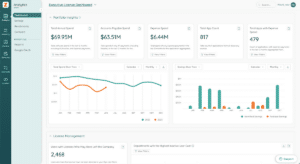
Zylo makes it easy to translate operational wins into strategic outcomes. Role-based dashboards let you segment by business unit, app owner, or category. License reclamation, app reductions, and contract savings are all trackable. You can show the value created for each function and deliver reports in formats that drive action.
Framing your results the right way can shift perception. Instead of just showing reclaimed licenses, you can show how your budget is preserved. Instead of surfacing app sprawl, you can demonstrate governance in action.
“It’s always the ‘what’s in it for me’ scenario. You have to find the currency that’s important for each leader that’s going to grab them and make them interested. Dollar signs are really pervasive across all stakeholders.”
— Siroui Mushegian, CIO at Barracuda Networks
Best Practices
Follow these best practices to report your SaaS Management quick wins and evangelize the program across your organization.
- Understand your audience and what’s important to them. Align reporting to stakeholder priorities—finance, security, procurement, or departmental leadership.
- Build role-based dashboards to track progress toward KPIs. Use your platform to visualize results by category, business unit, or metric.
- Share results consistently. Include program updates in quarterly reviews, budget meetings, and IT scorecards.
- Tell the story. Use before-and-after comparisons to highlight impact and reinforce why SaaS Management matters.
Start Strong, Scale Fast
You don’t need a massive program or full organizational buy-in to prove that SaaS Management works. You just need momentum—and the right platform to help you build it.
The six quick wins covered here—eliminating redundancy, reclaiming unused licenses, automating offboarding, remediating Shadow IT, and optimizing renewals—are proven plays for fast, measurable impact. They reduce waste, minimize risk, and generate the kind of executive visibility that turns operational wins into long-term support.
Zylo gives IT leaders the tools to execute these wins with clarity and precision. With the industry’s most complete discovery engine, automated workflows, embedded intelligence, and powerful reporting, Zylo helps you move faster and make smarter decisions with every contract, license, and user.
Whether you’re starting from scratch or scaling an established program, Zylo helps you go further—faster. Download the No-BS SaaS Management Playbook to dive deeper, or request a demo to see how Zylo can help you take action with confidence.


 — Trenton Cycholl, VP, Digital Business at ModMed
— Trenton Cycholl, VP, Digital Business at ModMed —
—